The Reverse Creaming Method for Cakes
Introducing Reverse Creaming also know as Two Stage Creaming.
This is the first in a series of 7 “Cake Batter” classes. Over the course of the series we’ll test how changes to cake batter mixing technique and ingredients can alter a cake’s taste and texture.
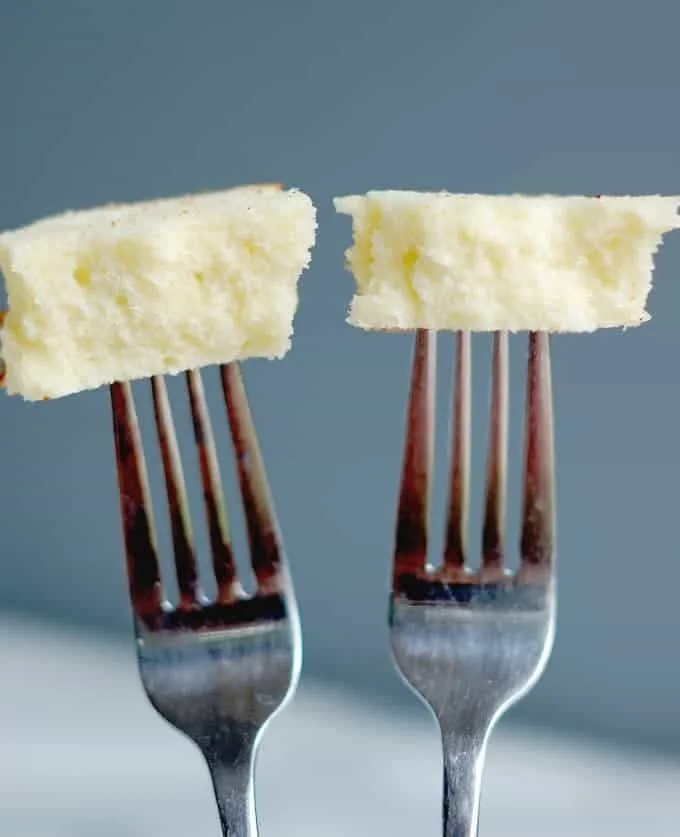
We’ll work with the original pound cake as our test recipe for the “Cake Batter” classes. Pound cake is a great tool for our purposes precisely because it’s a simple recipe with just 4 ingredients.
Pound cake got it’s name based on the original formula of 1 pound each of butter, sugar, eggs and flour. It’s called “quatre-quarts” (four-fourths) by the French.
For our science of cake batter series we’ll look at the role each ingredient plays in the batter. But first we’ll look at two cake batter mixing methods.
Traditional Creaming vs. Reverse Creaming
When I was in culinary school, our first lesson in the “cakes” section was the basic pound cake. Not only did we have to use the original “quatre quarts” recipe, we were required to cream the butter and sugar with a wooden spoon, by hand.
At the time it seemed a little ridiculous. We knew we’d never actually mix a pound cake by hand, especially in a pro kitchen.
But the exercise did reinforce how important technique is, not only for pound cake but for all baking.
What is the creaming method?
The traditional creaming method starts by beating together the butter and sugar. The sharp edges of the sugar crystals cut through the butter to create lots of little air bubbles. The eggs are added one at a time and the flour is added last.
As soon as the flour is added gluten, the protein in the flour that gives baked goods their structure, will start to form. As the cake bakes the air bubbles trapped in the butter will expand in the heat of the oven producing, in theory, a light and airy cake.
What is Reverse Creaming?
Reverse creaming, aka two-stage creaming, is an alternate technique used by many bakers (including me). Reverse creaming starts by beating together the flour, sugar and butter.
Gluten won’t start to form until the flour comes in contact with water (in the egg whites). Coating the flour molecules with butterfat before the eggs are added creates a barrier which slows the formation of gluten. Reverse creaming should, in theory, make a cake with a more tender and velvety texture.
Cake test – creaming versus reverse creaming
One way to compare mixing techniques is to run side-by-side tests. For each test I mixed one batch using the traditional creaming method and one batch using the reverse creaming method.
Each batch of cake contained exactly 8 ounces each of cake flour, granulated sugar, unsalted butter and eggs. The butter and eggs were at ideal room temperature, between 65-70°F.

- All ingredients were at ideal room temperature, about 65°-70°F.
- All cakes were baked in identical 9”x 5” loaf pans at 325°F in a convection oven.
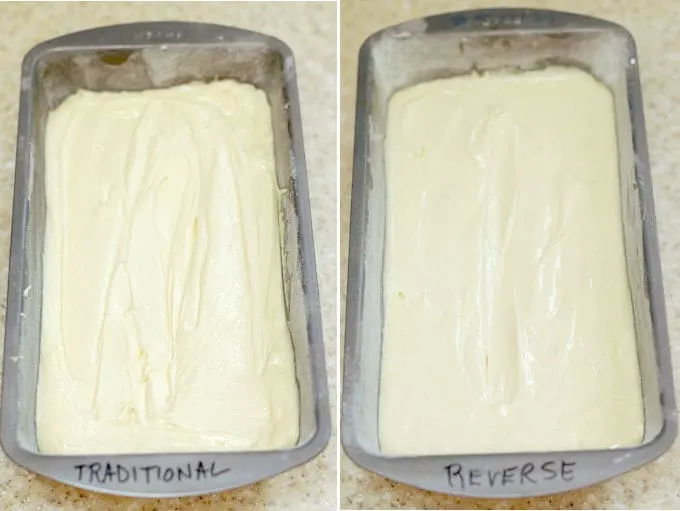
- The cake batters look similar going into the oven.
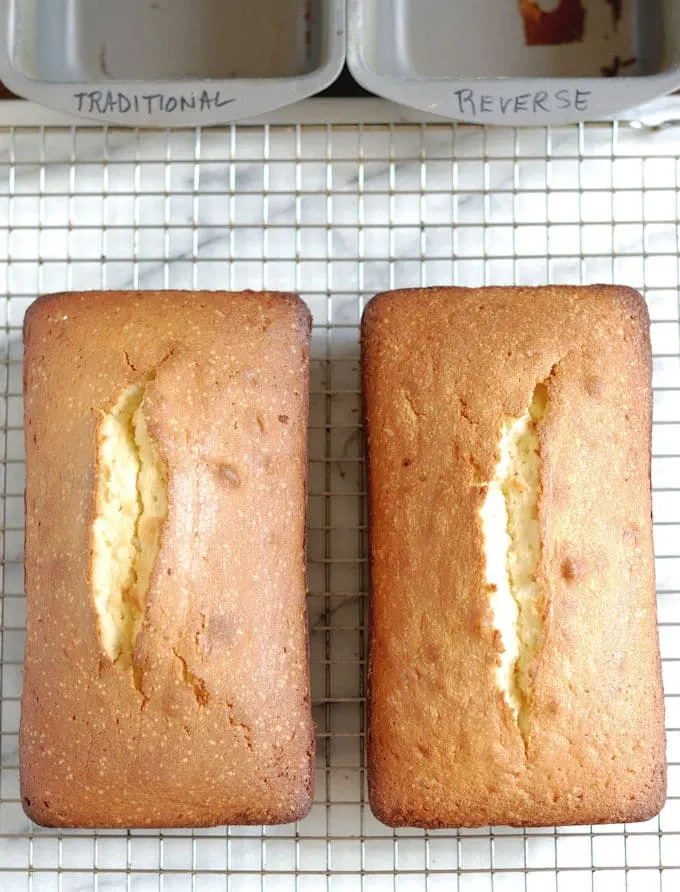
- The crusts on the cakes had slightly different texture.
Creaming vs. Reverse Creaming test results
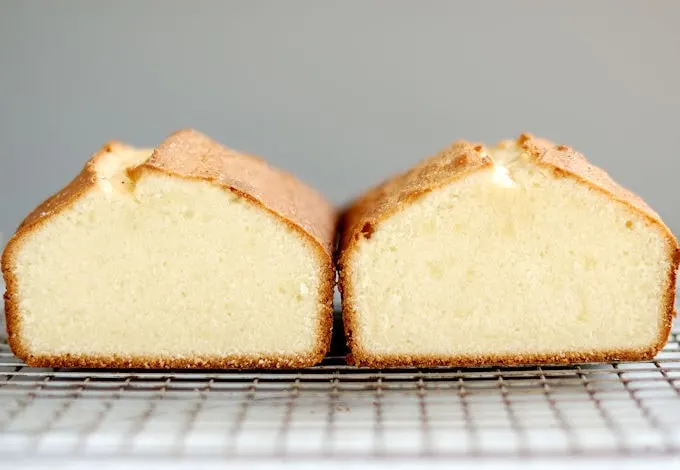
- At first glance, the cakes made with the different mixing methods looked very similar, but once I cut and tasted the cakes the differences became apparent.
- The cake made with the traditional creaming method had a very tight crumb and contained a few pockets of air. The cake was a little chewy with a slightly bouncy texture. I pinched a piece of the cake between my fingers and it held together a moment before breaking up.
- The cake made with the reverse method also had a tight crumb, but it was very consistent with no air pockets. The texture was softer and more tender. When I pinched a piece of that cake between my fingers it broke apart more easily.
Which is better, creaming or reverse creaming?
In tests using the exact same ingredients, a cake made with the reverse creaming method was softer and more tender. Which is why reverse creaming is my preferred mixing method.
Other cake batter classes:
Next up: Cake Batter Class #2 will explore how adding salt, flavorings and leavening can improve on the basic pound cake recipe.
- The function of flour in cake batter
- The function of eggs in cake batter
- The function of sugar in cake batter
- The function of fat in cake batter
- The Cake recipe formula
When we’re done experimenting with all the ingredients for this “cake batter” course, we’ll use all we’ve learned to create Pound Cake Perfection.

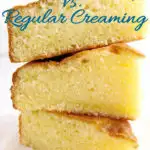
I came across your post and have enjoyed reading. I just ordered your book. I have a question. Why is it that anytime I use the reverse creaming method, my cakes shrink so much? I, at times, make them with success, and then other times (more frequently), they do not come out (the major shrinking). I use a scale to weigh ingredients. I do not over mix. I use room temp ingredients. I have an oven thermometer. My ingredients are fresh, including baking powder, etc. Can you please tell me what the problem may be? I love the texture of cakes with the reverse creaming method, however, I like a taller and fluffier cake, and not one that shrinks almost down to a pancake (so to speak). Thanks!
Hi Steph. Reverse creaming makes a cake very tender, so it may settle as it comes out of the oven. I have had cakes shrink back from the pan a bit as they come out of the oven, or the hump in the middle will settle into a flat top. But I’ve never had a cake deflate down to a pancake. A couple of things – don’t grease the sides of the pan. I either use just a parchment round at the bottom of the pan or just grease and flour the bottom. The sides of the cake will stick a bit and help it rise and it will shrink back a little less when it comes out of the oven. See the photos in my White Cake post. Make sure when you add he butter and “cream” it into the flour that you give it a good 3-4 minutes. The flour and butter mix should lighten in color and texture at this point. To me, the velvety texture of a reverse creamed cake is worth the tradeoff for a small loss in height. But again, I’ve never had a cake deflate to a pancake so I can’t say what is causing that.
Why is it that no leavening agent, for e.g. baking powder, is required here?
Hi Armywife, the “original” pound cake recipe which is simply a pound each of butter, sugar, flour and eggs, has no chemical leavening in the recipe and relies on incorporating air into the batter by creaming. So the original pound cake recipe is a great way to show how the different ways of mixing the batter can make a difference in the outcome of the cake. The recipe here is more about explaining how cake batter works. The original pound cake recipe is not my favorite recipe. If you want a better pound cake recipe, check out this post.
Hi. What size should the mold be if I want to make it with half the ingredients (one quarter of a pound each)?
This recipe was tested in a 9×5″ loaf pan. That pan has an 8 cup capacity. I have a 8.5×4.5″ loaf pan that has a 6 cup capacity. I also have some mini pans, 5.75×3.25″ that have a 2 cup capacity. So, depending on what pans you have available, I would look for a pan that has a 4 cup capacity or something close. You could probably get away with the 6 cup capacity pan and just have a slightly shorter loaf. To figure out the capacity of your pans just measure water, a cup at a time, and pour it into the pan until it’s full. By the way, if you’re looking for my favorite pound cake recipe, try my Pound Cake Perfection. It’s a little lighter and softer than the original recipe.
Hi Eileen,
Can you use the reverse creaming method with a cream cheese, sour cream pound or am I being overly ambitious? Thanks!
You can use reverse creaming with any recipe that uses the traditional creaming method. So, yes, it would work for cream cheese or Sour Cream Pound Cake.
Hi i wanna ask something about the reverse creaming method. Can i somehow cream the butter & sugar first until it’s light & fluffy, and then add in the flour after that? (The egg whites will still be added at the end)
And can i use the same amount of milk (or buttermilk) instead of the sourcream? Thanks a lot ♡
If you cream the butter and sugar first and then add the flour that is exactly the regular creaming method. This recipe will still work with the regular creaming method, I just prefer the texture with the reverse creaming. But you can do it either way. This recipe is the original pound cake recipe. I have posted my “Perfected Pound Cake” recipe in which I add a little milk (you can also use buttermilk).